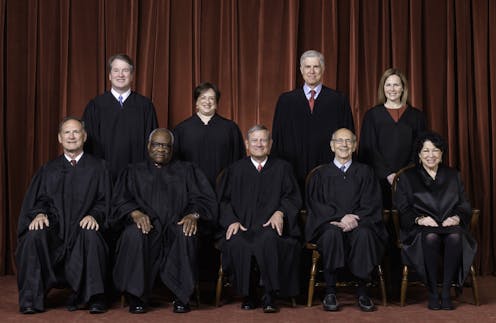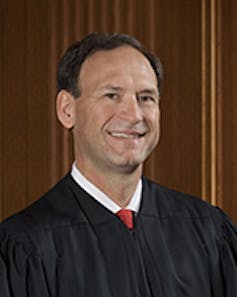Conservative Supreme Court justices disagree about how to read the law
In a 6-3 conservative majority, the more important divisions may be among the six Republican-appointed justices.

With a 6-3 majority, conservative justices on the Supreme Court may appear poised to hand down decisions that the Republican presidents who appointed them would applaud.
As a political scientist who has published several books on law and politics, I know it’s true that the political affiliation of the president who appointed a justice is a powerful indicator of how that justice will vote.
But ideology does not explain everything. Not all cases divide neatly along partisan lines, and, what’s equally important, Supreme Court decisions consist of more than votes. They also set forth judicial reasoning, which offers vital clues to differences in how justices read the law and how they might rule in future cases.
Often, conservative justices are associated with a doctrine of legal interpretation called “originalism,” which looks to the meaning of a law’s language when it was enacted to determine what Congress intended to achieve. So, in interpreting the Eighth Amendment’s prohibition on “cruel and unusual punishment,” an originalist would try to understand what “cruel and unusual” meant when the Bill of Rights was adopted in 1791 as opposed to now.
Originalism may seem straightforward in the abstract, but it can take several forms in practice, and that’s where members of the court’s conservative majority sometimes part ways. This has happened in two recent cases that illustrate how internal divides among that six-justice majority may be more consequential than the divisions between them and the three-justice liberal minority that garner so much attention.
Gorsuch’s literal approach in Bostock
A case called Bostock v. Clayton County, decided in 2020, consolidated three lawsuits against employers who allegedly fired workers for being gay or transgender. The workers all sued under Title VII of the Civil Rights Act of 1964, claiming sex discrimination.
In the decision, the conservatives split. Chief Justice John Roberts and Associate Justice Neil Gorsuch joined the court’s four liberals at the time – Associate Justices Stephen Breyer, Ruth Bader Ginsburg, Elena Kagan and Sonia Sotomayor – to rule in favor of the workers. The remaining conservatives, Samuel Alito, Brett Kavanaugh and Clarence Thomas, disagreed.

Gorsuch wrote the majority opinion. He started by looking at the definition of the word “sex” when the law was passed in 1964. Quoting the employers’ arguments, which relied on dictionaries from that time, Gorsuch assumed that “sex” meant a person’s “status as either male or female [as] determined by reproductive biology.”
Applying this definition, he concluded that sex discrimination encompasses sexual orientation and gender identity. After all, if employers punish male workers – but not women – for being attracted to men, or for exhibiting traits they would accept in female employees, they are treating individual workers differently at least partially based on the worker’s sex.
In dissent, Kavanaugh criticized Gorsuch’s literal approach and looked to the law’s customary understanding when written. Using this method, Kavanaugh reasoned that sex, sexual orientation and gender identity discrimination were considered distinct in 1964 – as they are now – and that therefore, Gerald Bostock was fired because he is gay, not because he is biologically male.
Alito, joined by Thomas, wrote a different dissent. It echoed many of Kavanaugh’s arguments, but took a harsher tone. Alito said the law should be read according to its meaning in 1964, and not “2020 values,” those from the year in which the case came before the court. The opinion said that ordinary Americans in 1964 “would not have dreamed that discrimination because of sex meant discrimination because of sexual orientation, much less gender identity.”
Alito’s dissent claimed Gorsuch was entirely misusing the idea of originalism. Gorsuch took an extremely close-up and literal view, applying a dictionary definition from when the law was passed without regard to further context. Kavanaugh sought to place this language in historical perspective to assess whether Congress intended an expansive definition of sex discrimination in 1964. Alito and Thomas took Kavanaugh’s approach to a more impassioned extreme.
Alito’s historical approach in Dobbs
The leaked draft of an upcoming ruling in Dobbs v. Jackson Women’s Health Organization, which emerged in May 2022, showcases Alito’s narrow brand of originalism.
The case is about a Mississippi law that bans abortions after the 15th week of pregnancy. The statute is plainly unconstitutional under Roe v. Wade and Planned Parenthood v. Casey, both of which guarantee the right to abortion before fetal viability – or about 23 or 24 weeks of pregnancy.

Alito’s draft opinion for the majority on the Dobbs case indicates it may be joined by Thomas, Kavanaugh, Gorsuch and the newly appointed associate justice, Amy Coney Barrett. If that were true, the ruling would be a 5-4 decision, with Chief Justice Roberts once again defecting from the conservative bloc.
Alito’s reasoning in the Dobbs draft is similar to his explanation in the Bostock ruling in three ways that highlight his approach to legal interpretation.
First, he begins with the language of the governing law. Alito finds no specific reference to abortion in the U.S. Constitution, and no implicit right to abortion in any other constitutional provision, including the due process clause of the 14th Amendment, which says the government shall not deprive a person “of life, liberty or property without due process of law.”
Second, Alito argues that when the governing law is silent (or ambiguous) on issues, judges should let the elected branches decide them. In the Dobbs draft, he calls the finding of implied rights in Roe an “abuse of judicial authority.”
Third, Alito argues that history holds the key to reading the law. He says that any argument that abortion is implicitly included in the 14th Amendment’s due process clause fails because in 1868, the year the amendment was ratified, 28 of the 37 states criminalized abortion at all stages of pregnancy. And, he notes, eight of the remaining nine states passed laws doing so before 1910.
Alito further claims that the ruling would not mean the end of other constitutionally protected rights, like interracial marriage and same-sex marriage, because abortion is “unique” in that it destroys an “unborn human being.” But this statement is what lawyers call “dicta” – comments that are incidental to the resolution of the case. In fact, Alito’s legal methodology is not limited to abortion rights or even constitutional law, as seen from its use in the Bostock ruling.
The broader point is that justices’ reasoning matters. Just as Gorsuch’s literal approach to reading Title VII’s ban on sex discrimination potentially affects other statutes, Alito’s historical approach casts doubt on other decisions that rely on the due process clause, including cases establishing the right to gay marriage and contraception.
Conservatives’ debate over what methods to use to interpret text remains fluid. Gorsuch wrote the majority opinion in Bostock but appeared ready to join Alito’s draft in Dobbs. Whether he actually does will be central to that case’s final outcome, as well as impending battles over other constitutional and statutory rights – even when the court is dominated by conservatives.
Jeb Barnes has received funding from the National Science and Robert Wood Johnson Foundations.
Read These Next
As DOJ begins to release Epstein files, his many victims deserve more attention than the powerful me
Powerful men connected to Jeffrey Epstein are named, dissected and speculated about. The survivors,…
The world risks forgetting one of humanity’s greatest triumphs as polio nears global eradication − 7
Polio may finally be defeated in the next 5 years. Will the world recognize what an extraordinary achievement…
People are getting their news from AI – and it’s altering their views
Even when information is factually accurate, how it’s presented can introduce subtle biases. As large…





